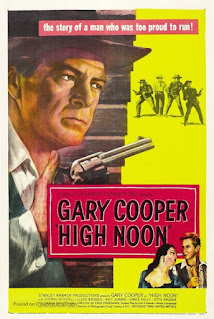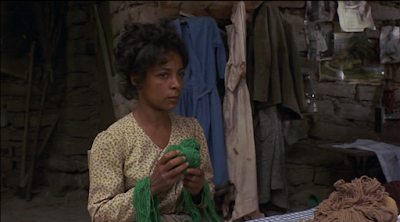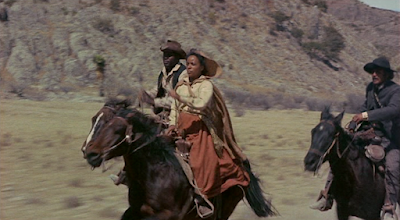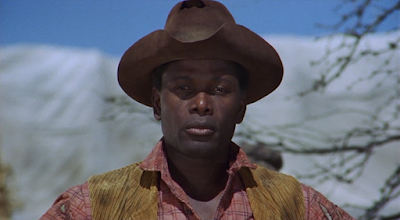Black pioneers? Black cowboys? Did those exist? Why, yes, as a matter of fact, they did. Not only did they exist, they were a major force in settling the west, especially after the American Civil War. Black pioneers headed west by the thousands, looking for a place to start over far from the land where they had been enslaved -- forty thousand or more. Many of them were part of the 1879 "Exoduster Migration" to Kansas, but many others went in small groups whenever and however they could.
Sadly, Hollywood has largely ignored this aspect of Old West history. Buck and the Preacher (1972) is the only feature film that focuses on this mass migration. Black characters show up in other westerns, sure. But they're usually side characters, co-stars, or part of an ensemble cast. Buck and the Preacher broke that tradition.
Former Army sergeant Buck (Sidney Poitier) leads wagon trains of hopeful settlers to new homes on land they've purchased in Kansas. He's done this successfully in the past, many times, paying the native tribes whose land they cross for safe passage and even supplies. He's respected by the natives and trusted by the people he leads.
Some plantation owners in Louisiana get angry when all their former slaves decide to move west instead of staying on as sharecroppers to work the same land where they were once enslaved. Those owners hire a killer called Deshay (Cameron Mitchell) to kill Buck and take the would-be settlers back to Louisiana. Deshay and a band of vicious followers attack a wagon train Buck has just lead to land they've purchased and mean to settle. The night riders kill most of the livestock and draft animals and terrorizing the people.
But Buck isn't there. He's finished his job and headed off to visit his wife Ruth (Ruby Dee) at their own homestead. Deshay tracks Buck there and try to ambush him, but he escapes.
Buck leads his attackers away from his home and wife, pushing his horse until it's exhausted. Then he spots an isolated campfire with an unattended horse. Desperate to keep ahead of his pursuers, Buck decides to trade his horse for this fresh one, since its owner is nowhere around.
As a matter of fact, the horse's owner, a slick-talking con artist called Preacher (Harry Belafonte), is sitting naked in a nearby creek, reveling in a nice, cold bath. Preacher notices Buck saddling up his horse and tries to stop him, but he's unarmed and unclothed, so there's not much he can do. At least Buck leaves his own horse in trade and doesn't just strand Preacher there.
Of course, that's not the last time Buck and Preacher meet up. Before long, they have reluctantly joined forces to outwit Deshay and his men.
Buck is determined to lead another wagon train to Kansas, but Deshay attacks it and not only brutalizes and kills many of the pioneers, but finds and steals the money they were saving to buy food for the winter and seeds for the spring. Without it, they will starve.
Buck and Preacher come up with a daring plan to steal the money back, with Buck's wife Ruth's help. When it goes awry, they come up with an even more daring plan. Once they've returned the money to the settlers, Buck and Ruth plan to head to Canada to start a family in a land untainted by even the memory of slavery. Preacher's plans for the future remain ambiguous, even to him.
Sidney Poitier not only starred in this movie, he directed it too. He wasn't planning to direct it, but the original director left early in the shooting, so Poitier took over, even though he had never directed a movie before. He proved to have a talent for it, and went on to direct eight more movies after that.
This is one of the very rare 1970s westerns that I actually like. It doesn't try to provide entertainment by being crude or gross, or by trying to shock or titillate the audience, which far too many '70s movies do. Yes, it's violent, but the violence is more like a '60s western, not relying on gore or spurting blood to keep you interested in the story.
Aside from the violence, is this movie family friendly? Well, probably not for most kids, no. There's one brief instance of rear male nudity as Preacher skedaddles out of the creek in an effort to stop Buck from taking his horse. There's a little suggestive behavior and dialog, enough that it would be rated PG-13 today, but that rating didn't exist back in 1972. It's implied that a woman was assaulted and probably raped. The night riders patronize a whorehouse, though no adult activities are shown. There's some bad language here and there. I would not call this movie family friendly, but it would be good for older teens and adults to see because it presents an often-overlooked part of history in a respectful and uplifting way. Or, you could watch it with a filtering service if any of them carry it.

This review is my latest addition to our 2022 Legends of Western Cinema Week celebration! And, yes, the button above is a shot from this movie.
Click here to go to the main post and see the list of all the other things people have contributed to this event. And don't forget to
enter my giveaway!


















































